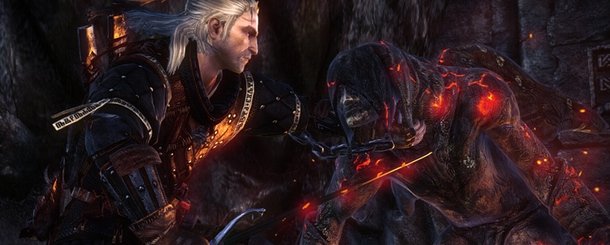The Witcher 2 Tweaks Guide

The Witcher 2 is one of the most beautiful games you'll play this year, but getting it to run well can be problematic. To switch on every graphical option and crank up the fidelity, you'll need a beast of a computer. For everything else, follow this guide to squeezing a few more frames per second out of the action without compromising its ability to impress you.
First things first: When you have to choose between frame-rate and graphics, choose frame-rate. The Witcher 2 is incredibly sensitive to choppy action during combat, where timing is absolutely essential and you will die if you can't respond immediately to what's happening on screen.
One of the most common recommendations on Nvidia systems is to go into Control Panel and remove the 3D specific drivers. Both Nvidia and ATI systems have issues at the moment, but should be fixed with the first patches - due out very soon. Don't try to fiddle with the visual options from the Control Panel, as you're only likely to end up staring at half-rendered screens.
Most of the options in the Settings application go without saying. It currently seems to struggle with getting the right balance for many systems though, so take its definitions of Low, Medium, High and Ultra with a grain of salt. As ever, the higher quality you set effects like shadows, the slower your game will be, you'll get a big boost by changing down the resolution (at the expense of the graphics looking much more smeared), and the smaller the textures the game has to deal with, the better it'll handle lower spec graphics cards. If you're on anything less than a decent dual core with a graphics card from the last couple of years that has at least 1GB of RAM, along with 4GB of regular memory, expect to have to compromise to get a decent frame rate as well as snappy looks - although even on the lower settings, The Witcher 2's raw assets makes it look a hell of a lot better than most other RPGs.
By far the biggest performance killer is Ubersampling. If you don't have a monster PC, switch it off immediately. Next, if you're getting a lot of crashes, turn the texture memory size down a couple of notches - especially if you're trying to run on less than 1GB of video memory (which really, you shouldn't be). Switch off the rarely used Blur effects, including Motion Blur, and deactivate regular Depth of Field. The Cinematic version may help too, but only kicks in for dialogue and cut-scenes where a steady frame-rate isn't required. You can also happily switch off Vertical Sync, which won't make much difference to the game, but will boost your performance by a good chunk. Keep SSAO active if you can.
With all these switched off, fire up the game. You want - at minimum - a decent 20-25FPS if the game is going to be playable. (If you don't have a dedicated frame counter, try FRAPS ). The opening cut-scene of Geralt in the woods isn't an ideal test for this. See how the performance is during the opening flashbacks by leaping into a fight and watching how well the system performs. The easiest way to do this is to jump into the second of the flashbacks, which begins with a pitched battle. The animations and controls are already clunkier than many other games, so don't expect perfect smoothness out of the game. It's worth making a savegame just before this fight so that you can jump straight back into the action - as long as you don't leave the siege tower, you should be able to do this with no problem. Once you've confirmed that this is running okay, head back and start turning the graphical options back on, saving Ubersampling for last (possibly compensating by dropping other settings, like antialiasing).
For other tweaks, you need to leave the setting screen. If you need to invert the mouse, open the user.ini file in your Witcher 2 directory, find 'MouseSensitivityY" and change it to a negative number.
The biggest gaming news, reviews and hardware deals
Keep up to date with the most important stories and the best deals, as picked by the PC Gamer team.
Moving away from performance, the first mods have only just started to come out - but a few are worth grabbing. The first is Remove Intros , which gets rid of the eighteen billion pointless cut-scenes every time you start the game up. We also suggest checking out Zero Item Weight , which is something of a cheat, but not one that will actually impact the game very much, except to save you the bother of having to clean house using the ghastly inventory UI when you just want to pick up a new bit of armour. There's also an Increased Capacity Mod if you don't want to take things that far. Neither is essential, but you might find them useful. The other mods out there are the moment are much cheatier, including the ability to slap mutagens onto all of your skills (a major game unbalancer) and to make potions and oils last longer (less problematic, since ingredients are very rarely in short supply - but definitely not in keeping with the point of the alchemy system). The game is already unbalanced enough without these though, especially when this stuff would kick in, so we'd suggest steering clear for the moment.
Have you found any tweaks that helped you get better performance? Share them here...

